As an Amazon Associate KitchenwareSets.com earns from qualifying purchases.
11 Kitchen and Dining Room Ideas For Small Modern Spaces
Feeling cramped in your own home? Does your kitchen feel more like a closet, and your dining area an afterthought squeezed into a corner? You’re not alone. Trying to balance the daily demands of cooking, eating, and living in a compact kitchen and dining room combo is a common frustration for many. It’s a constant battle between needing functional prep space and wanting a stylish spot to enjoy a meal.
The challenge is real: how do you fit everything you need without the space feeling cluttered, dark, and inefficient? You want a kitchen that inspires you to cook and a dining area that feels welcoming, not just a place to quickly eat before clearing the table for another task. The good news is, you don’t need a massive renovation or a bigger home to achieve this.
A combined kitchen and dining room, often called an “eat-in kitchen” or “kitchen-dining combo,” is a space where cooking and dining areas are integrated. To maximize a small combo space, focus on smart layouts, multi-functional furniture, vertical storage, and a light color palette to create an illusion of spaciousness. We’ve helped countless homeowners tackle this exact challenge, turning cramped quarters into beautifully efficient spaces. This guide compiles our most effective, expert-approved strategies.
Feeling Cramped? How to Make Your Small Kitchen and Dining Room Feel Twice as Big
A combined kitchen and dining room, also known as an “eat-in kitchen,” is a space where cooking and dining areas are integrated into one room. The best way to make your small kitchen and dining room feel bigger is to focus on clever design strategies that maximize both real and perceived space, including vertical storage, multi-functional furniture, and light-reflecting surfaces. We’ve helped countless homeowners tackle this exact challenge, turning cramped quarters into beautifully efficient spaces. This guide compiles our most effective, expert-approved strategies to help you reclaim your space and create a kitchen-dining combo you’ll love to live in.
11 Kitchen and Dining Room Ideas to Transform Your Small Space in 2025
Ready to transform your compact kitchen and dining area from cramped to chic? These aren’t just pretty pictures; they are 11 practical, achievable strategies designed to solve the most common small-space problems. Each idea is curated based on proven interior design principles for maximizing small footprints, ensuring both beauty and daily functionality. From smart layouts and clever furniture to the transformative power of color and light, you’ll find the inspiration you need to create a space that feels open, airy, and perfectly suited to your modern lifestyle.
1. Go Vertical: Maximize Storage by Reaching for the Ceiling
The most effective way to gain storage in a small kitchen is to install ceiling-height cabinets or shelving, which draws the eye upward and utilizes every inch of available wall space, making the room feel taller.
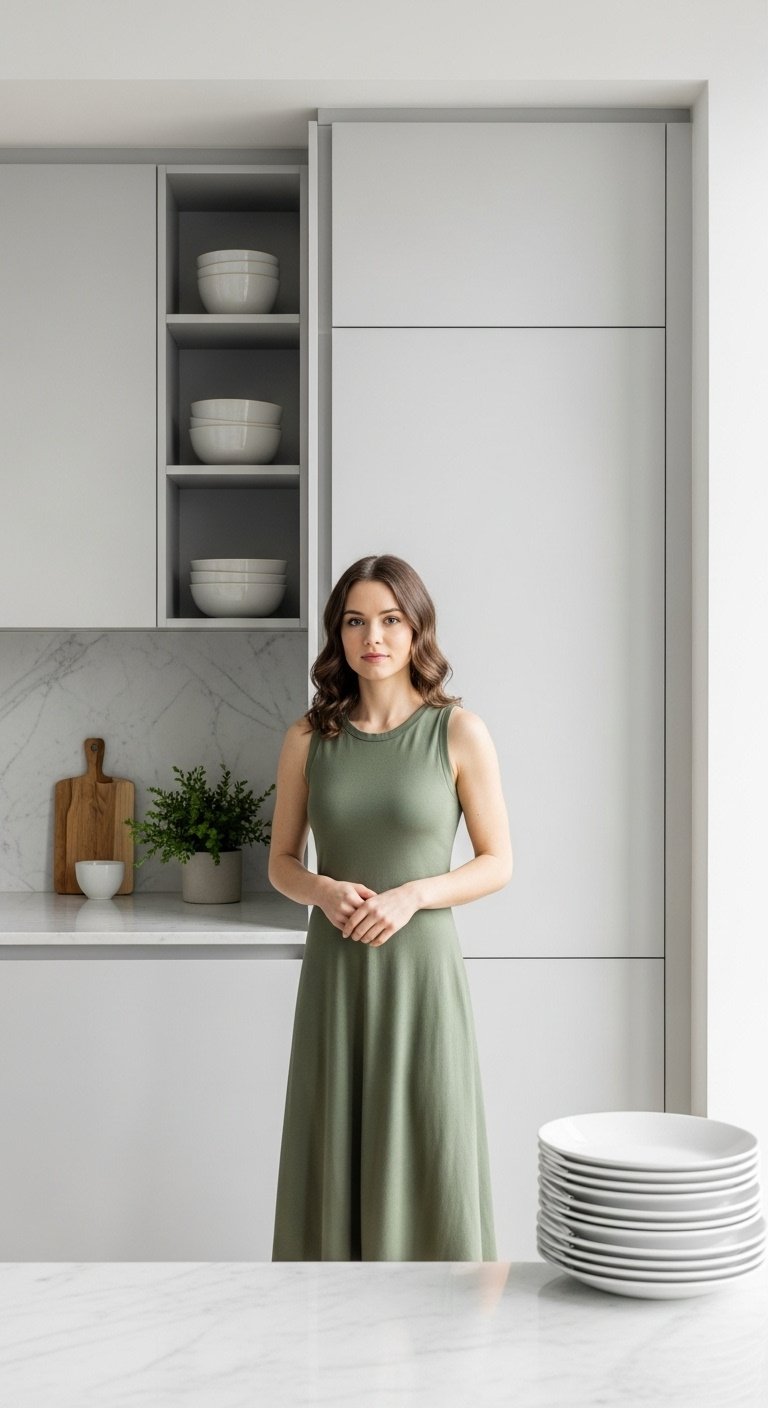
Most standard kitchens leave an awkward, dust-collecting gap between the top of the cabinets and the ceiling. By eliminating this gap, you not only gain valuable storage for less-frequently used items but also create a seamless, custom look that visually elongates the walls.
How to Implement Vertical Storage:
- Materials Needed: Tape measure, stud finder, drill, level, ceiling-height upper cabinets or shelving units, appropriate screws and anchors.
- Step-by-Step Directions:
- Measure: Carefully measure the wall height from countertop to ceiling to ensure your new cabinets or shelves will fit.
- Locate Studs: Use a stud finder to mark the location of wall studs for secure installation.
- Install Uppers: Mount the ceiling-height cabinets or top-most shelves first, ensuring they are perfectly level. Work your way down.
- Organize: Place less-frequently used items on the highest shelves and daily-use items within easy reach.
Pro-Tip: If custom cabinets aren’t in the budget, install a single floating shelf just below the ceiling around the perimeter of the room. It’s perfect for decorative items and visually draws the eye up.
Pin this vertical storage hack to your ‘Small Kitchen Solutions’ board!
2. The Cozy Corner: Integrate Built-In Banquette Seating
A built-in banquette is an incredibly space-efficient seating solution because it pushes the dining area directly into a corner, eliminating the dead space required to pull chairs in and out on two sides.
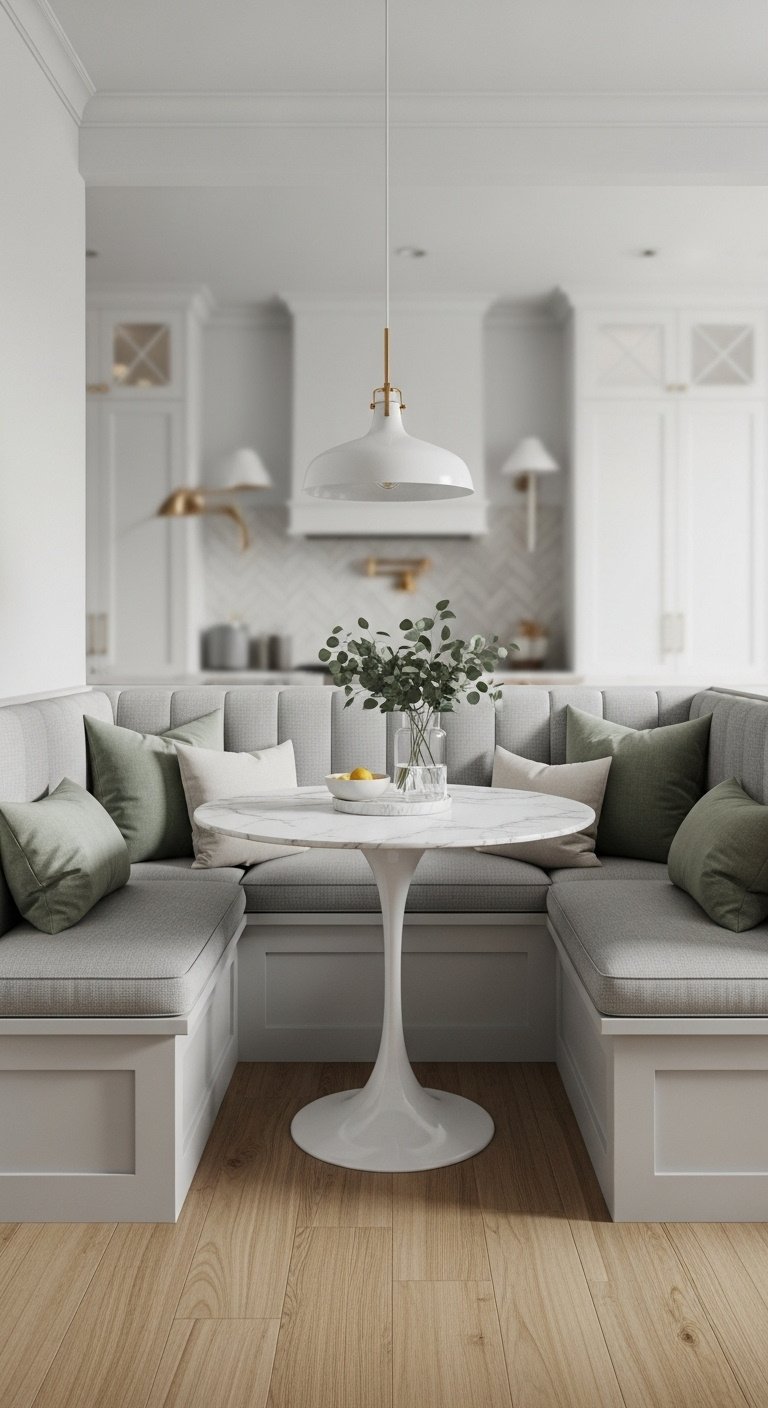
Beyond saving space, banquettes create a cozy, restaurant-booth vibe that’s perfect for casual family meals. Plus, the bench seating often includes a hidden superpower: built-in storage underneath the seat, perfect for stashing placemats, seasonal decor, or small appliances.
How to Build a DIY Banquette:
- Materials Needed: Plywood or MDF for the frame, 2×4 lumber for support, foam cushions, upholstery fabric, screws, wood glue, finishing nails.
- Step-by-Step Directions:
- Design & Measure: Measure your corner and design the L-shaped bench. A typical seat height is 18 inches and depth is 20-24 inches.
- Build the Frame: Construct the base frames using 2x4s and cover them with plywood or MDF. Plan for hinged tops if you want built-in storage.
- Secure and Finish: Secure the benches to the wall studs. Sand, prime, and paint the base to match your kitchen decor.
- Add Comfort: Top the benches with custom-cut foam cushions wrapped in a durable, easy-to-clean fabric.
Lesson Learned: Opt for a pedestal table with a banquette. It eliminates table legs that get in the way, making it much easier to slide in and out of the seating.
Save this cozy nook idea to your ‘Dream Home’ Pinterest board!
3. The Transformer: Invest in an Extendable or Fold-Down Table
Multi-functional furniture is key in small spaces, and an extendable or fold-down table provides maximum flexibility, allowing you to keep floor space clear for daily life while still being able to host guests.
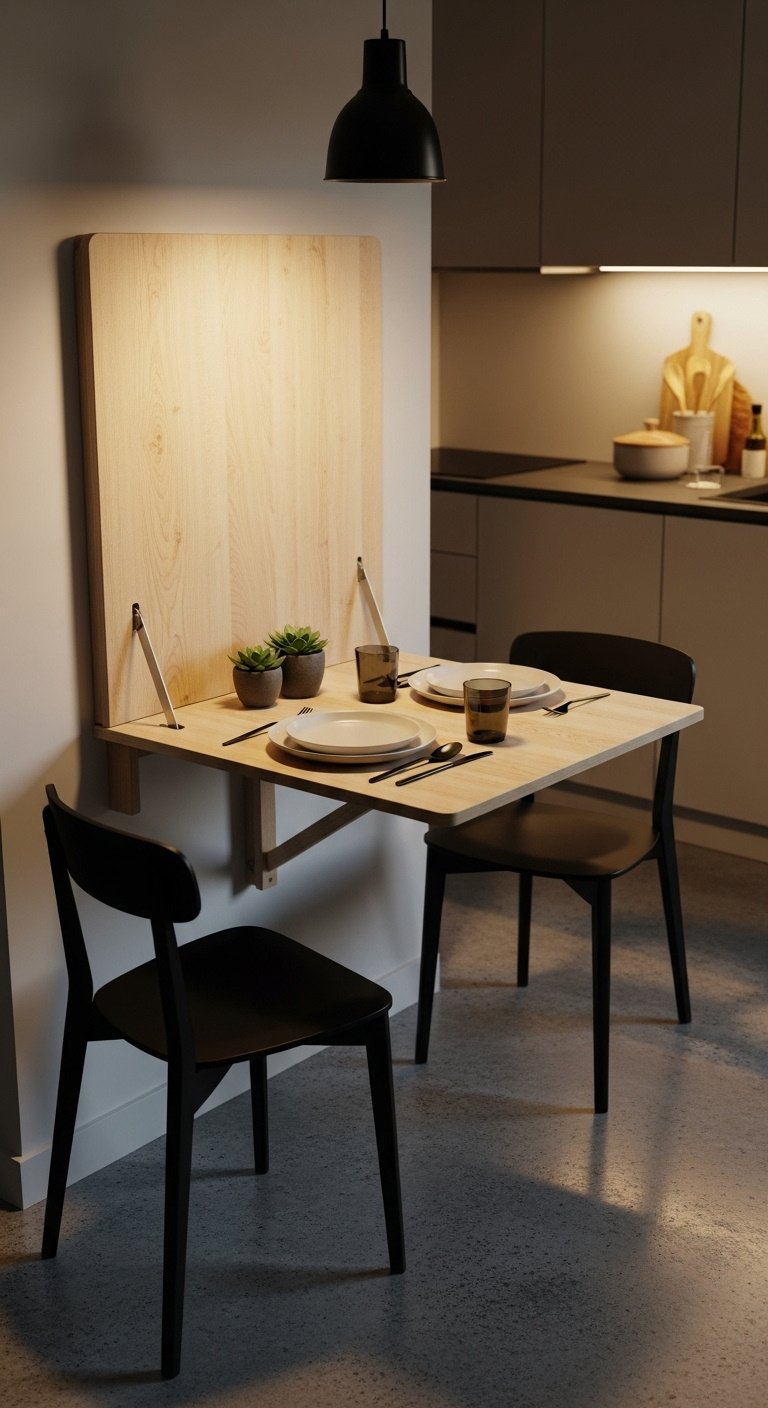
For the ultimate space-saver, a wall-mounted drop-leaf table folds away to almost nothing when not in use. For those who entertain more often, a modern extendable table can comfortably seat two for breakfast but expand to accommodate four or six for dinner.
How to Install a Wall-Mounted Table:
- Materials Needed: A solid piece of wood (e.g., butcher block), heavy-duty hinges, a sturdy leg with a locking mechanism, wall anchors, screws, drill, level.
- Step-by-Step Directions:
- Choose Location: Identify a clear wall space large enough for the table when folded down.
- Attach to Wall: Secure one side of the tabletop to the wall at your desired height (approx. 30 inches) using heavy-duty hinges attached to wall studs.
- Install the Leg: Attach the folding leg to the underside of the outer edge of the table. Ensure the locking mechanism is secure for when the table is in use.
- Test: Fold the table up and down to ensure it operates smoothly and is level and stable when extended.
Pro-Tip: When choosing an extendable table, look for one with a self-storing leaf. This avoids the hassle of having to find a separate place to store the extension piece.
Love flexible furniture? Pin this idea for your small space!
4. The Light Reflector: Use a Light and Neutral Color Palette
A light and neutral color palette—think whites, creams, and soft grays—is essential because these shades reflect natural and artificial light, which instantly makes a small room feel larger, brighter, and more open.
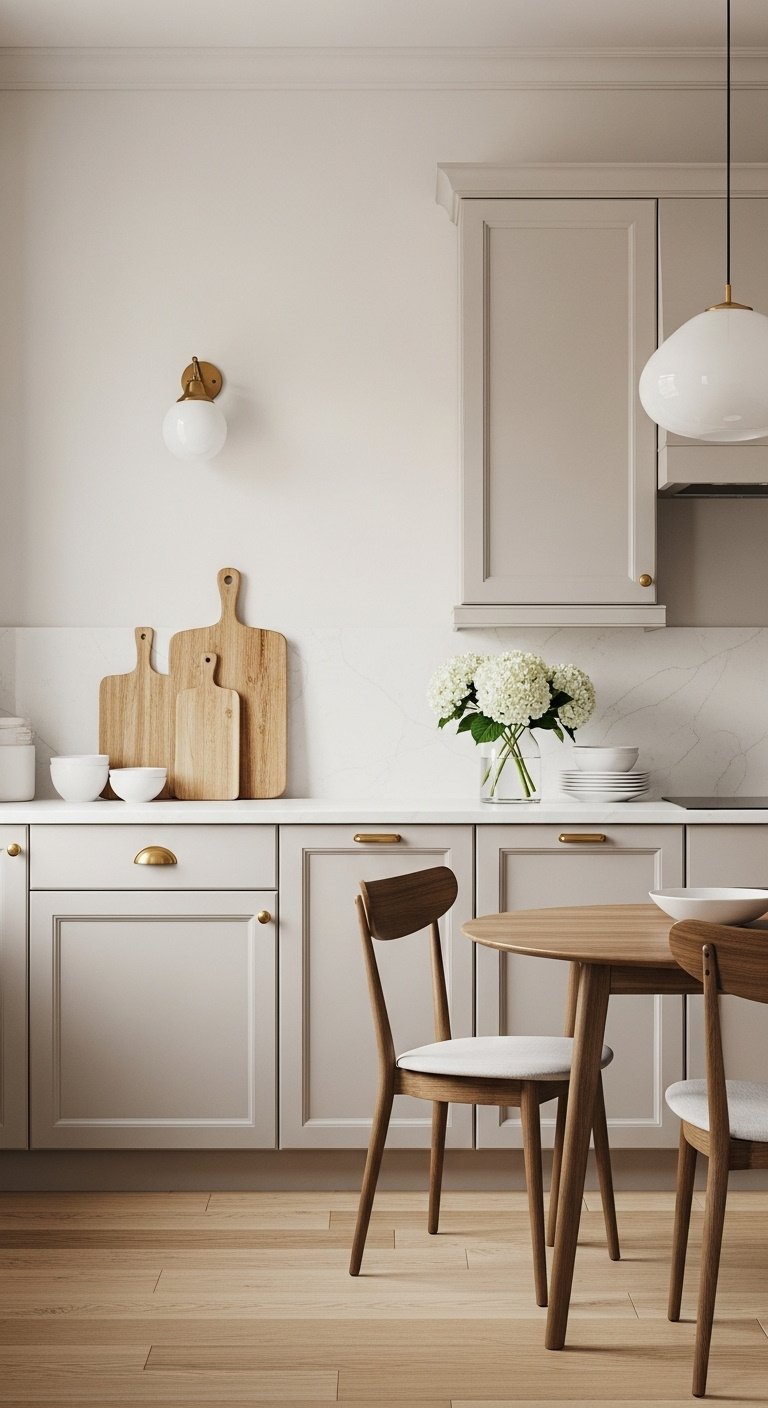
Dark colors absorb light and can make walls feel like they are closing in. By painting walls, cabinets, and even the ceiling in similar light tones, you create a seamless, cohesive look that blurs the room’s boundaries and enhances the sense of space.
How to Paint for a Spacious Feel:
- Materials Needed: High-quality interior paint in a light neutral shade (e.g., eggshell or satin finish), painter’s tape, drop cloths, rollers, brushes, primer (if needed).
- Step-by-Step Directions:
- Prep the Space: Clear the room, cover floors and furniture with drop cloths, and apply painter’s tape along trim, ceilings, and countertops.
- Choose Your Sheen: Select an eggshell or satin finish. They are durable and have a slight sheen that helps reflect light without being overly glossy.
- Apply a Cohesive Color: Paint the walls and ceiling the same light color to blur the lines where they meet, making the ceiling feel higher. Consider painting cabinets a similar shade for a seamless look.
- Layer Tones: Introduce slight variations of your neutral color through textiles (dish towels, cushions) and decor to add depth and prevent the space from feeling sterile.
Pro-Tip: Don’t forget the ceiling! Painting it a crisp, bright white—or even the same light color as the walls—is one of the most effective ways to make a small room feel significantly larger.
Pin this serene color scheme to your ‘Home Decor Inspo’ board!
5. The Illusionist: Add Glossy and Reflective Surfaces
Incorporating glossy and reflective surfaces is a designer trick that bounces light around the room, creating an illusion of depth and making the space feel more expansive and glamorous.
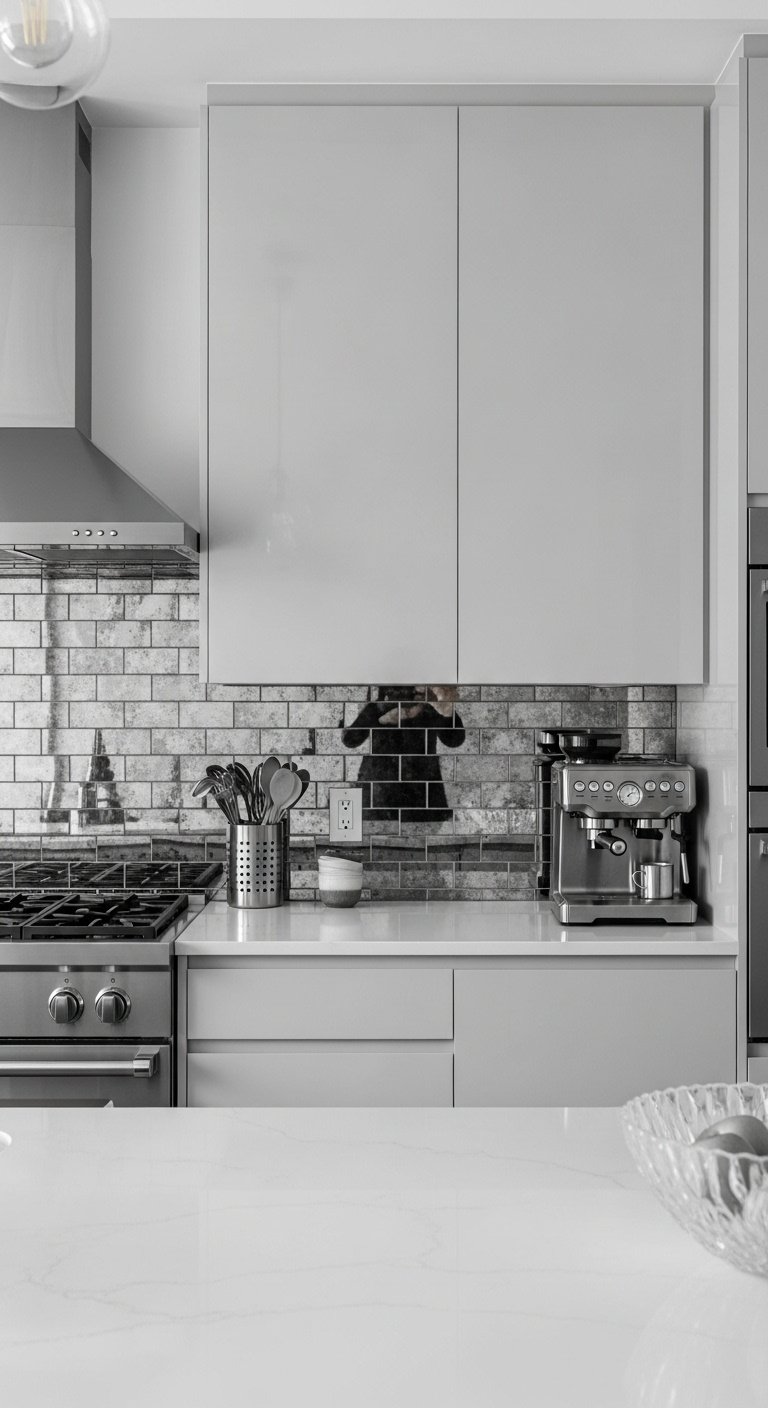
Think beyond just a mirror. High-gloss cabinets, a polished quartz countertop, stainless steel appliances, and a mirrored or glass tile backsplash all work together to amplify your kitchen’s light source, whether natural or artificial.
How to Install a Mirrored Backsplash:
- Materials Needed: Mirrored tiles, tile adhesive (mastic), notched trowel, tile cutter or glass cutter, non-sanded grout, grout float, sponge.
- Step-by-Step Directions:
- Prepare Wall: Ensure the wall is clean, dry, and flat.
- Apply Adhesive: Spread a thin layer of tile adhesive onto a small section of the wall with the notched trowel.
- Set Tiles: Press the mirrored tiles into the adhesive, using tile spacers for even gaps. Make cuts as needed for outlets and edges.
- Grout and Clean: After the adhesive cures (24-48 hours), apply non-sanded grout with a float, pressing it into the gaps. Wipe away excess grout with a damp sponge and let it cure. Polish the mirrors once dry.
Lesson Learned: A little goes a long way. If a full mirrored backsplash is too bold, try using a large, simple framed mirror on one of the dining area walls. It will reflect the space and light, acting like another window.
Ready to shine? Save this reflective design trick to your Pinterest!
6. The Flexible Friend: Bring in a Rolling Kitchen Cart or Island
A rolling kitchen cart provides crucial extra prep space and storage that can be moved out of the way when you need more floor space, offering the benefits of an island without the permanent commitment.
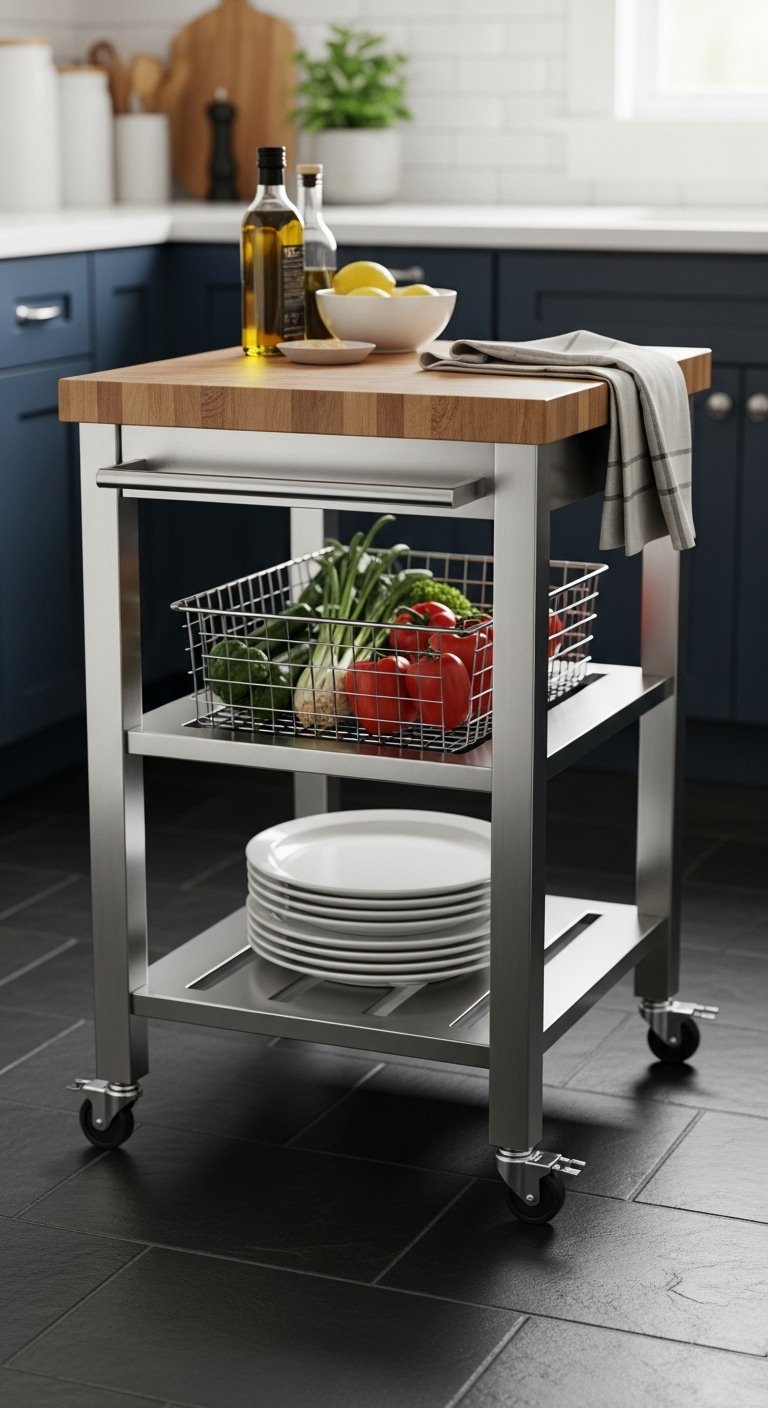
This versatile piece can serve as a coffee bar, a small baking station, or even a serving buffet when guests are over. Look for one with shelves, drawers, and a durable top like butcher block or stainless steel to maximize its utility.
How to Choose and Set Up a Kitchen Cart:
- Materials Needed: A pre-made kitchen cart/island kit OR lumber, butcher block top, heavy-duty locking casters, screws, wood glue, paint or stain.
- Step-by-Step Directions:
- Assess Needs: Determine the ideal size for your space and what you need most: more countertop, shelving, or drawer space.
- Assemble or Build: Follow the manufacturer’s instructions to assemble a kit. If building from scratch, construct a simple box frame and add shelves or drawers as desired.
- Attach the Top: Securely attach a durable top, like a butcher block, which can be used for food prep.
- Add Wheels: Install heavy-duty locking casters on all four corners. The locking feature is crucial for safety and stability when the cart is in use.
Pro-Tip: Look for a rolling cart with a drop-leaf extension. It can serve as a compact prep station most of the time and fold out to become a small dining table or buffet for two.
Pin this flexible kitchen solution for later!
7. The Artful Organizer: Install Minimalist Open Shelving
Strategically placed open shelving can replace bulky upper cabinets, reducing visual weight and making a small kitchen feel significantly more open and airy.
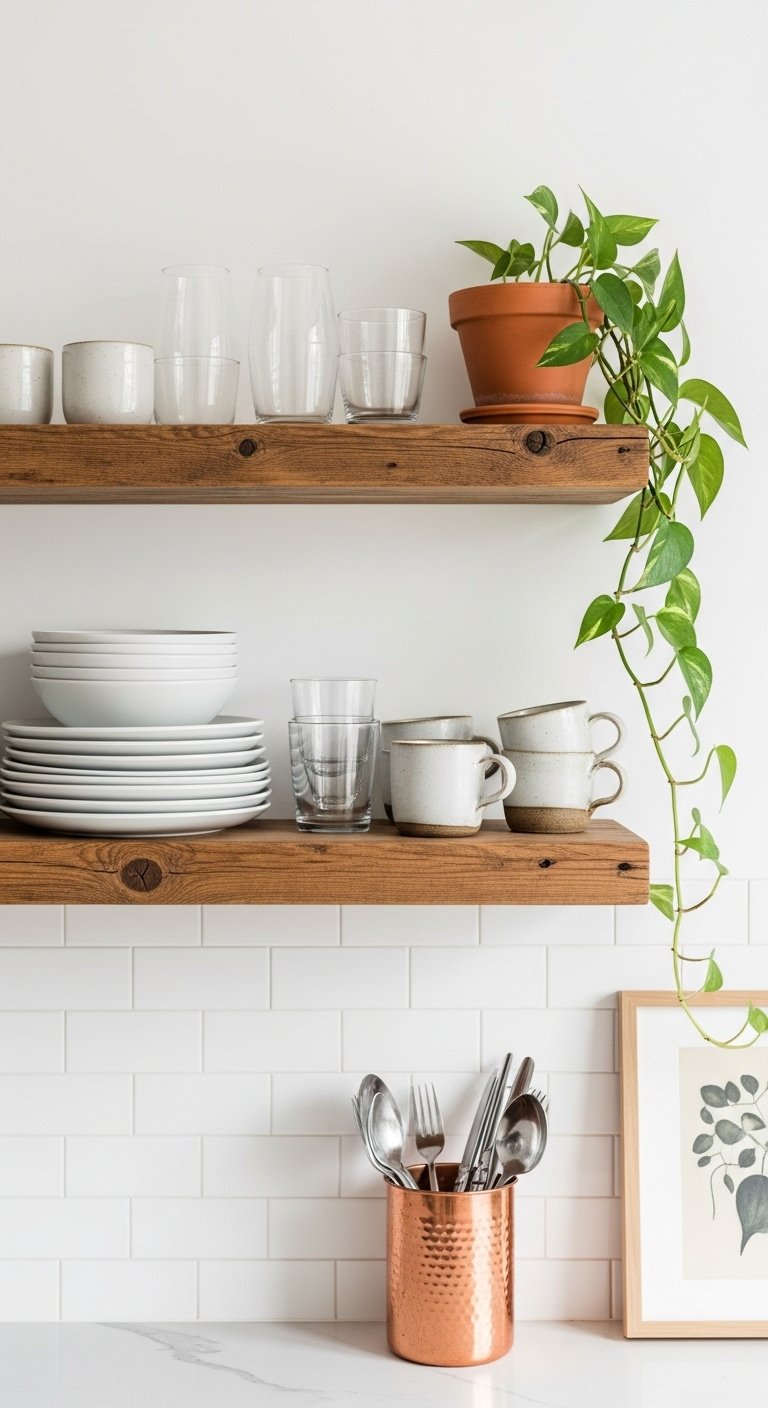
This approach allows you to store everyday items like plates and glasses within easy reach while also providing a space to display beautiful dishware, plants, or art, adding a personal touch to your kitchen.
How to Install and Style Open Shelves:
- Materials Needed: Floating shelf kit OR solid wood planks and heavy-duty brackets, stud finder, level, drill, wall anchors.
- Step-by-Step Directions:
- Plan Layout: Use painter’s tape to mock up the shelf placement on the wall. This helps visualize spacing and height.
- Locate Studs: Mark the wall stud locations for the most secure installation. Use heavy-duty wall anchors if a stud is not available.
- Install Brackets/Mounts: Securely attach the brackets or floating shelf mounting hardware to the wall, ensuring they are perfectly level.
- Curate & Style: Place your most-used, attractive items (e.g., matching plates, glasses, mugs) on the shelves. Mix in a small plant or a piece of art, but resist the urge to overfill them.
Lesson Learned: The key to successful open shelving is strict curation. Store mismatched or less attractive items in lower cabinets. This isn’t for all your stuff, just your best stuff.
Get inspired! Pin this beautifully styled shelf idea.
8. The Mood Setter: Layer Your Lighting for Function and Ambiance
A layered lighting scheme, combining ambient, task, and accent lighting, is crucial for making a small kitchen more functional while also adding visual depth and creating a warm, inviting atmosphere.
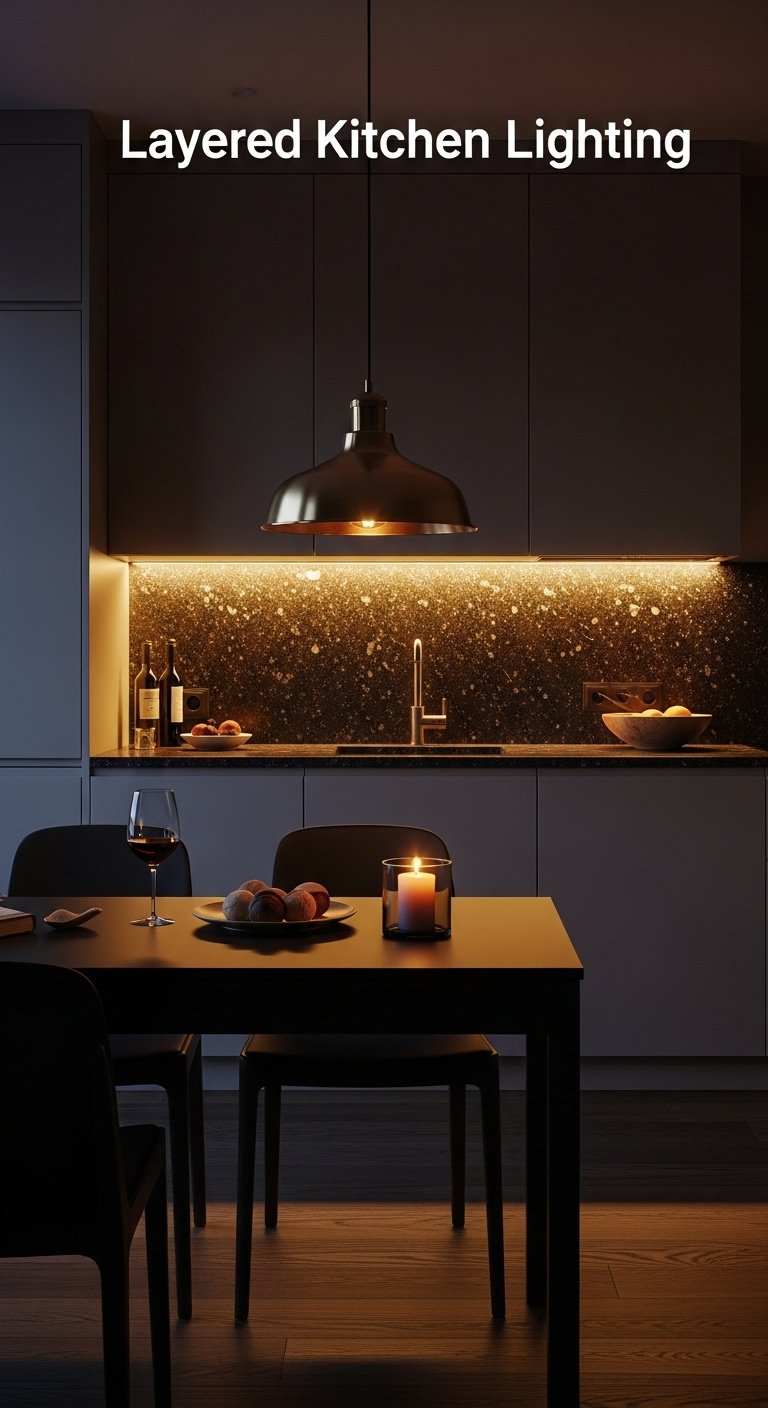
One single overhead fixture creates harsh shadows. Instead, combine recessed ceiling lights for overall (ambient) illumination, under-cabinet LED strips for bright (task) lighting on your countertops, and a stylish pendant light over the dining table to define the space (accent).
How to Install Under-Cabinet Lighting:
- Materials Needed: LED light strips or pucks, tape measure, power source (plug-in or hardwired), mounting clips or adhesive backing, wire concealers.
- Step-by-Step Directions:
- Measure and Cut: Measure the underside of your cabinets and cut the LED strips to length at the designated marks.
- Clean Surface: Thoroughly clean and dry the surface where you will be mounting the lights.
- Mount Lights: Peel off the adhesive backing and press the strips firmly into place, or use the included mounting clips for a more secure fit.
- Connect Power: Plug the lights into a nearby outlet or follow electrical instructions for a hardwired installation. Use wire concealers to hide any visible cords for a clean look.
Pro-Tip: Put your lights on dimmer switches. This gives you ultimate control, allowing for bright task lighting when cooking and soft, ambient light when dining or relaxing.
Brighten up your feed! Pin this lighting inspiration.
9. The Golden Rule: Perfect the “Working Triangle”
Adhering to the “working triangle” principle ensures an efficient and ergonomic workflow by placing the three main work zones—the sink, stove, and refrigerator—in a triangular layout with clear pathways.
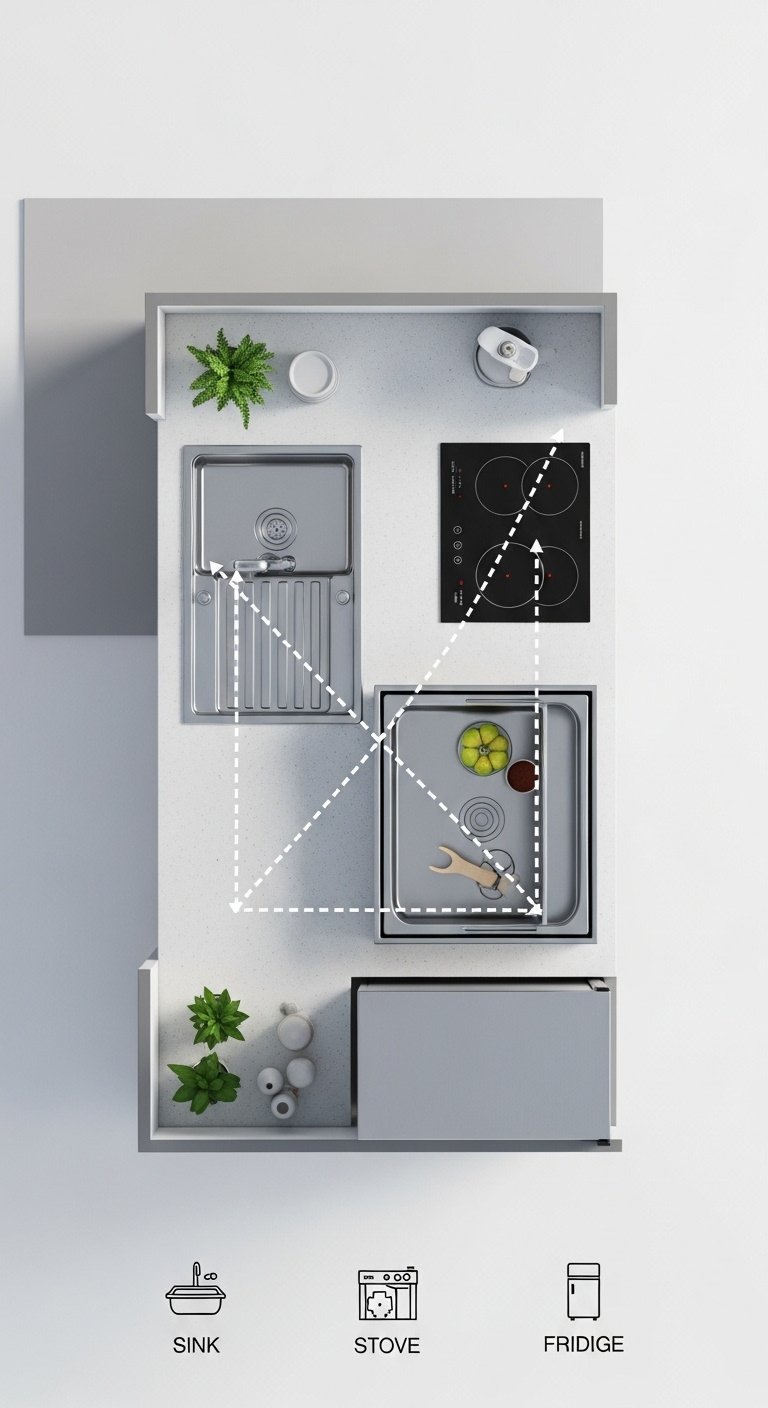
Even in a tiny kitchen, this concept is vital. It minimizes the steps you take between key tasks, making cooking and cleanup feel seamless rather than chaotic. An efficient layout is the invisible foundation of a great kitchen, regardless of its size.
How to Plan Your Working Triangle:
- Materials Needed: Graph paper and pencil, or free online kitchen planning software. Tape measure.
- Step-by-Step Directions:
- Measure Your Space: Accurately measure your kitchen’s dimensions, including doors and windows.
- Identify the Three Points: Locate your sink, stove, and refrigerator on your plan. These are the three points of your triangle.
- Draw the Triangle: Draw lines connecting the center front of each of these three appliances.
- Check the Rules: For optimal flow, each leg of the triangle should be between 4 and 9 feet long. The total length of all three legs should be between 13 and 26 feet. Most importantly, ensure the triangle’s pathways are not obstructed by an island or other obstacles. L-shaped and galley layouts often work best in small kitchens.
Lesson Learned: In very small kitchens, it might be more of a “work line” than a triangle. The principle remains the same: keep the three main zones close to each other with clear counter space in between to minimize steps and maximize efficiency.
Pin this essential kitchen design rule for your renovation plans!
10. The Disappearing Act: Opt for Backless and Stackable Seating
Choosing backless stools or stackable chairs is a smart move because this type of seating minimizes visual clutter and can be tucked away completely, keeping walkways open and making the dining area feel less crowded.
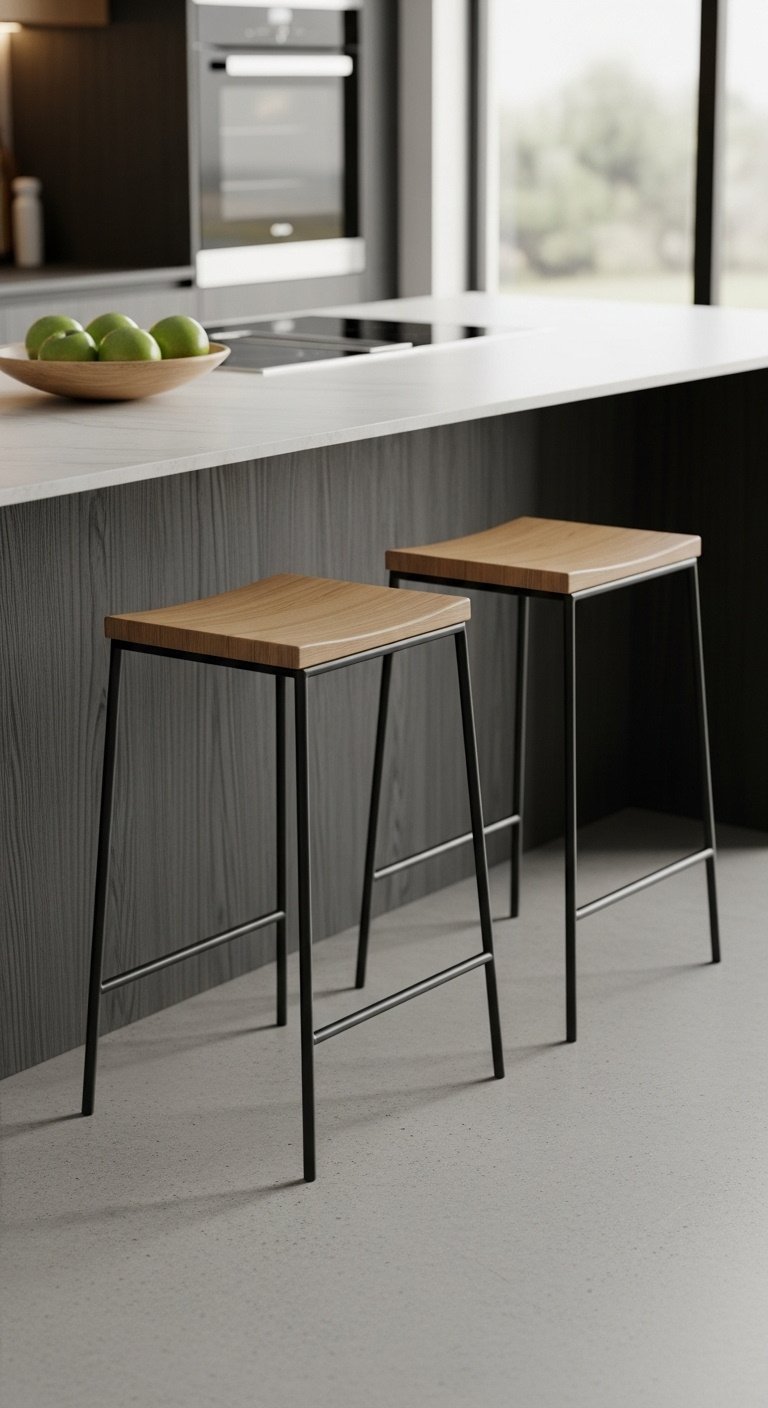
High-backed chairs can act like visual walls, chopping up a small space. Backless stools slide completely under a counter or table, while stackable chairs can be neatly stored in a corner when not in use, freeing up valuable floor space.
How to Choose Space-Saving Seating:
- Materials Needed: Your chosen stackable chairs or backless stools. Felt pads for the bottoms of the chair/stool legs.
- Step-by-Step Directions:
- Measure Table/Counter Height: Before buying, measure the height of your dining table or counter. Standard table height is 28-30″, requiring chairs with a seat height of ~18″. Counter height is 35-39″, needing stools with a seat height of ~24-27″.
- Choose a Style: Select stools that can be completely tucked under the table or counter when not in use. For chairs, look for designs specifically labeled as “stackable” that can be neatly stored in a corner.
- Protect Your Floors: Apply felt pads to the bottom of the legs to prevent scratching your floors when moving or stacking the seating.
Pro-Tip: Consider transparent acrylic (or “ghost”) chairs. They are visually weightless and practically disappear into the room, making them one of the best choices for maintaining an open, airy feel in a small dining space.
Save this clever space-saving seating idea to your ‘Apartment Living’ board!
11. The Statement Piece: Design a Bold Backsplash Focal Point
Using a bold, patterned, or colorful backsplash creates a powerful visual focal point that adds personality and style without taking up any physical space, drawing attention to a single high-impact feature.
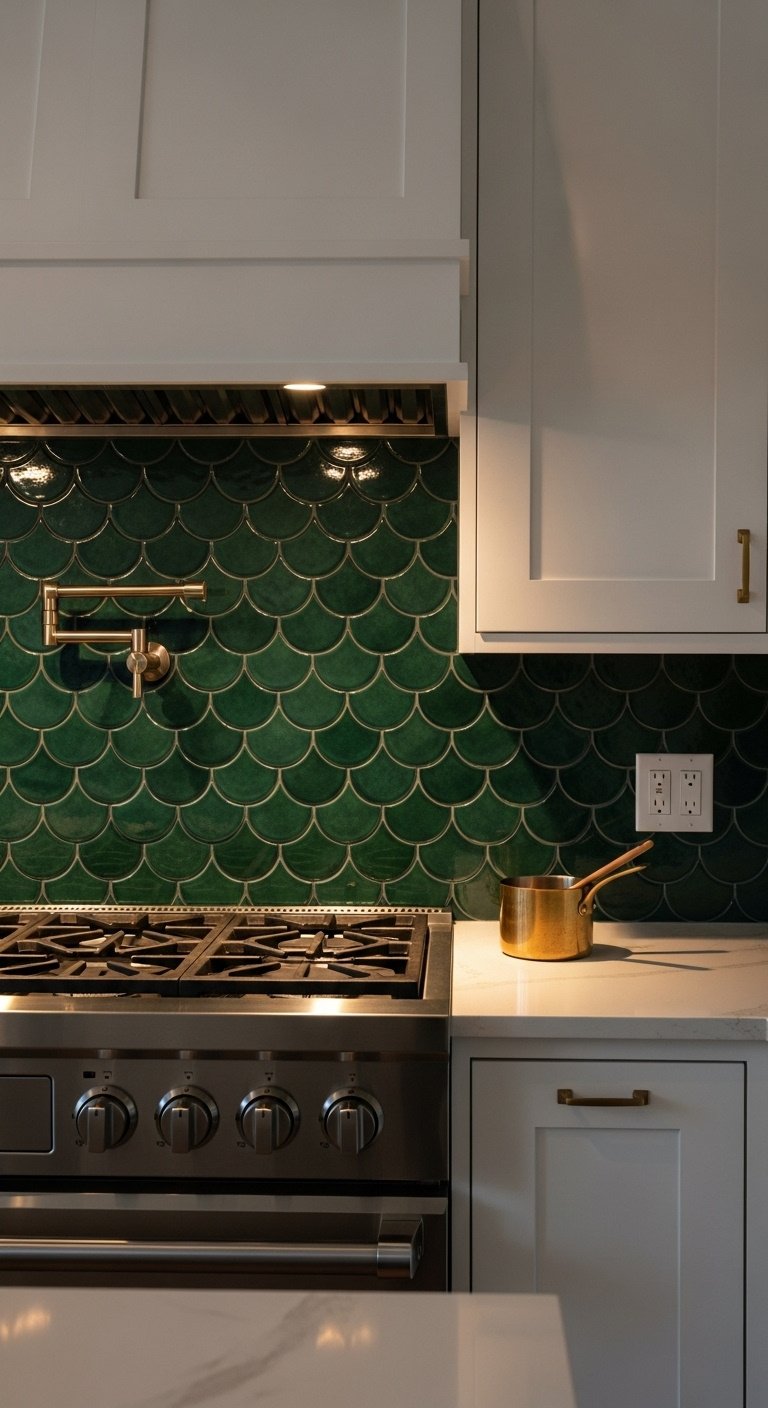
In a small, neutral kitchen, a “wow” moment backsplash prevents the design from feeling bland. It’s a chance to inject your personal style—be it with geometric patterns, rich jewel tones, or textured zellige tiles—and make your small kitchen feel thoughtfully designed and unique.
How to Install a Statement Backsplash:
- Materials Needed: Your chosen statement tiles (e.g., geometric, zellige, or a bold color), tile adhesive, grout, notched trowel, grout float, wet saw, level, sponge.
- Step-by-Step Directions:
- Select Your Tile: In a small kitchen, a bold pattern or color in a contained area (like the space behind the stove) can create a focal point without being overpowering.
- Create a Layout: Lay out your tiles on the floor first to finalize the pattern and minimize awkward cuts.
- Install the Tile: Apply adhesive to the wall and set your tiles, working from the center line outwards to ensure the pattern is symmetrical. Use a wet saw for precise cuts around outlets.
- Grout and Seal: Once the adhesive is cured, apply grout to fill the gaps. After the grout cures, apply a grout sealer to protect it from stains.
Lesson Learned: When using a bold backsplash, keep the surrounding elements simple. Pair a busy patterned tile with solid, neutral-colored cabinets and countertops to let the backsplash be the star of the show.
Dare to be bold! Pin this statement backsplash for your future kitchen.
Key Takeaways: Your Quick Guide to a Bigger, Brighter Kitchen & Dining Space
Feeling overwhelmed? Don’t be. Transforming your small kitchen and dining area comes down to a few core principles. Here is a quick-reference guide to the most impactful strategies:
- Think Vertically: Use ceiling-height cabinets and shelving to draw the eye upward and maximize storage.
- Choose Smart Furniture: Opt for multi-functional pieces like extendable tables, rolling carts, and banquettes with hidden storage.
- Reflect the Light: A light, neutral color palette combined with glossy or mirrored surfaces will make the space feel open and airy.
- Minimize Footprints: Select backless stools or stackable chairs that can be tucked away to keep pathways clear.
- Create a Focal Point: Use a bold backsplash or a unique light fixture to add personality without adding clutter.
People Also Ask About kitchen and dining room ideas
What is the golden rule of kitchen design?
The golden rule of kitchen design is the “kitchen working triangle.” This principle suggests that the three main work areas—the sink, the stove, and the refrigerator—should form a triangle. The pathways between these points should be clear and efficient, ideally with each leg of the triangle measuring between 4 and 9 feet.
How do you combine a small kitchen and dining room?
To combine a small kitchen and dining room effectively, use a cohesive color palette and flooring to unify the space. Opt for space-saving furniture like a banquette, a small round table, or a kitchen island with seating. Ensure clear pathways and use lighting to define the zones while maintaining an open feel.
What is the dining room trend for 2025?
The dining room trends for 2025 focus on functionality and natural warmth. Key trends include expandable or modular tables for flexibility, the use of natural wood finishes on tables and chairs, and incorporating unique shapes in furniture. The goal is to create inviting, adaptable spaces that feel both modern and comfortable.
What do you call a combined kitchen and dining room?
A combined kitchen and dining room is most commonly called an “eat-in kitchen.” It can also be referred to as a “kitchen-dining combo” or, in a larger open-plan space, a “kitchen-living room.” It’s defined by having a dedicated dining area within the kitchen space itself.
Final Thoughts
A small space doesn’t mean you have to sacrifice style, function, or the joy of a beautiful home. As you’ve seen, a few strategic choices in layout, furniture, color, and lighting can completely transform a cramped kitchen and dining area into a bright, efficient, and welcoming heart of your home. By embracing these ideas, you can create a space that not only looks bigger but also lives better.
Which of these ideas are you most excited to try in your home? Let us know in the comments below
